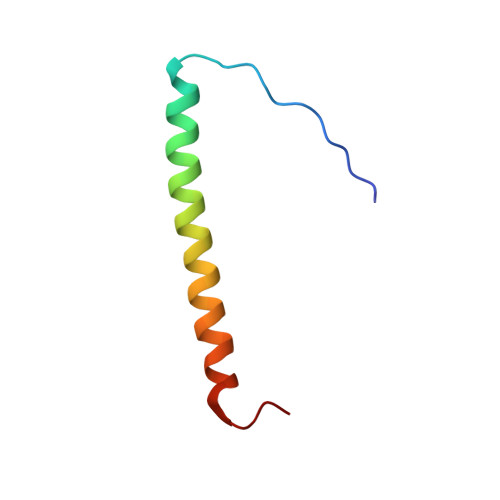Intramembrane ionic protein-lipid interaction regulates integrin structure and function.
Guo, J., Zhang, Y., Li, H., Chu, H., Wang, Q., Jiang, S., Li, Y., Shen, H., Li, G., Chen, J., Xu, C.(2018) PLoS Biol 16: e2006525-e2006525
- PubMed: 30427828
- DOI: https://doi.org/10.1371/journal.pbio.2006525
- Primary Citation of Related Structures:
5ZAZ - PubMed Abstract:
Protein transmembrane domains (TMDs) are generally hydrophobic, but our bioinformatics analysis shows that many TMDs contain basic residues at terminal regions. Physiological functions of these membrane-snorkeling basic residues are largely unclear. Here, we show that a membrane-snorkeling Lys residue in integrin αLβ2 (also known as lymphocyte function-associated antigen 1 [LFA-1]) regulates transmembrane heterodimer formation and integrin adhesion through ionic interplay with acidic phospholipids and calcium ions (Ca2+) in T cells. The amino group of the conserved Lys ionically interacts with the phosphate group of acidic phospholipids to stabilize αLβ2 transmembrane association, thus keeping the integrin at low-affinity conformation. Intracellular Ca2+ uses its charge to directly disrupt this ionic interaction, leading to the transmembrane separation and the subsequent extracellular domain extension to increase adhesion activity. This Ca2+-mediated regulation is independent on the canonical Ca2+ signaling or integrin inside-out signaling. Our work therefore showcases the importance of intramembrane ionic protein-lipid interaction and provides a new mechanism of integrin activation.
Organizational Affiliation:
State Key Laboratory of Molecular Biology, Shanghai Science Research Center, CAS Center for Excellence in Molecular Cell Science, Shanghai Institute of Biochemistry and Cell Biology, Chinese Academy of Sciences, University of Chinese Academy of Sciences, Shanghai, China.














